Denon AVR-X2800H Reviewed at $1,199.00
Product Name: Denon AVR-X2800H
Product Description: 7.2 CH 8K AV Receiver
-
Design - 9/10
9/10
-
Audio Quality - 9.1/10
9.1/10
-
Inputs / Ports - 9.2/10
9.2/10
-
OS, Apps and Features - 9.5/10
9.5/10
-
Price / Quality - 8.9/10
8.9/10
Summary
Reviewed at $1,199.00
Pros
- Amazing surround and Atmos performance
- 3 full 40Gbps HDMI 2.1 ports
- Refreshed UI
- Huge list of extras and services
Cons
- No front HDMI input for one more year
- Main unit and remote design need a refresh
- Audyssey MultEQ Editor app is not free
- More expensive than previous releases
Cheapest Places to Buy :
*We are a reader-supported website. When you buy through links on our site, we may earn a small affiliate commission at no extra cost to you. Home Media Entertainment does not accept money for reviews.*
Denon may have been part of Sound United for some time, along with sister brand Marantz, but they have managed to keep their distinct identity that made them such a fan favorite all these years. And while Denon makes a lot of products, their AV receivers is surely the crown jewel of their entire product lineup. As such, today in our Denon AVR-X2800H review we will be looking at their latest release and if it has anything new to offer compared to its predecessor.
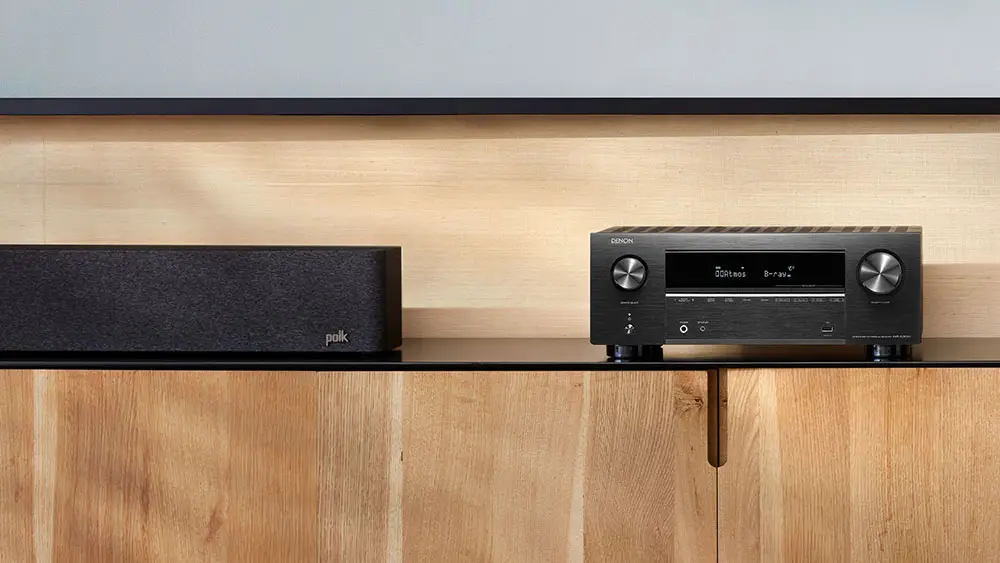
Since 2020, when the first HDMI 2.1 AV receivers came out with the dreaded HDMI 2.1 bug, we are waiting for an update on their X series of AV receivers and it seems that the time finally came. Recently Denon announced two new models, the AVR-X2800H and the AVR-X3800H, that will be available from now while two more, the AVR-X4800H and the AVR-A1H, will arrive early next year.
We will talk more about the X3800H in a future review as today we will focus on the smaller of the two, the X2800H. The receiver is a 7.2 channels unit with 95 watts of built-in amplification per channel, it supports the standard by now Dolby Atmos and DTS:X along with the usual virtual and up-mixing tech like Dolby Surround, DTS Neural:X, Dolby Atmos Height Virtualization and DTS Virtual:X, uses the Audyssey MultEQ XT auto calibration system and includes plenty of features like High Resolution Audio, HEOS technology, AirPlay 2, voice control, custom integration as well as bi-amp capabilities, multi-room zones and HDMI 2.1 ports.
At first glance the AVR-X2800H seems awfully similar to the X2700H. But there is more to it than meets the eye so let’s dive deep into its specs to see what changes has Denon made for their latest offering.
Design
In terms of design it seems that Denon decided not to change anything compared to the X2700H. Looking at the two receivers side by side does not reveal any change whatsoever, other than the different model number of course.
The unit measures exactly the same at 17.1″ x 13.4″ x 9.3″ (434 x 341 x 237 mm) with the antennas in vertical position. You can slightly minimize its height to 6.6″ (167 mm) if you turn them horizontally without any loss on wireless quality and thus strikes a perfect balance between size and capabilities.
In terms of actual looks it seems that Denon is pretty comfortable with the design they have although we would like to have a refresh just like Marantz did with their new releases. Featuring straight lines and sharp corners this is your typical black box receiver that looks uninspiring, even a bit outdated compared to the competition. The front features a brushed metal texture with an exact shame layout as the previous 2019 and 2020 releases.
This means a big central display showing all functions with two big circular knobs at each side for volume on the right and source selection on the left. Under the source selection knob we find the power button while a thin line under the central display houses 10 function buttons that include tuner and zone 2 controls, Dimmer, Status and four quick selection buttons.
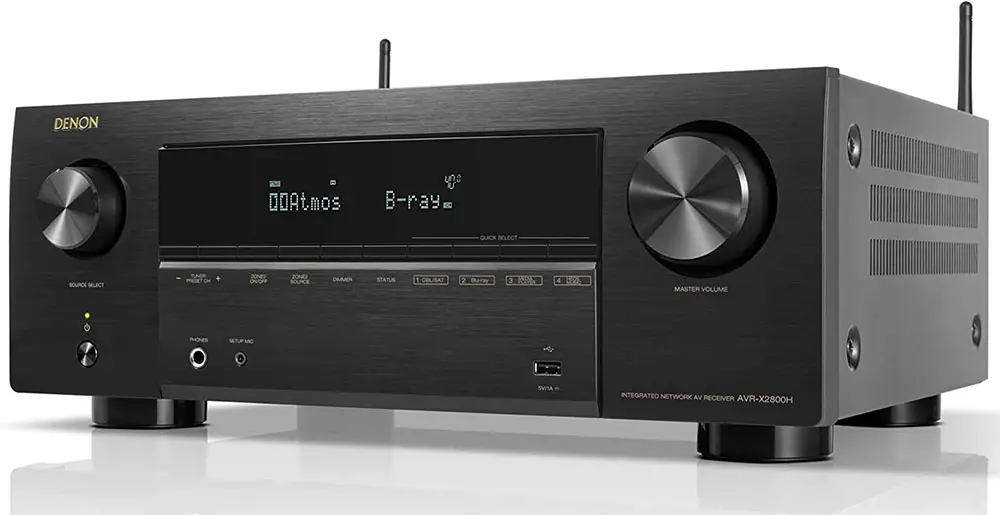
Under these buttons, as usual, we get the front ports with the headphones jack and setup microphone port on the left and a single USB port on the right that can be used to stream audio from a USB based external storage like a flash drive. Next to the USB was used to be the front HDMI port but the arrival of HDMI 2.1 in 2020 models seems to be the reason for taking this out.
We were hoping that the next batch of AV receivers would include this again but alas this was not the case. We will keep asking for this and hopefully one day Sound United will decide to bring back the front HDMI port that we consider such a convenient and practical feature.
Looking at its insides we find the receiver featuring discrete high-current amplifiers on all channels with low-impedance drive capability while its four 32-bit D/A converters allow for high resolution audio decoding while providing low distortion and the widest possible dynamic range.
The AVR-X2800H’s remote is very similar to previous Denon receivers but is not entirely the same as it seems there are some minor changes in the 2022 version. Code named RC-1253 the remote comes in the same color and design as previous ones and the changes we find here is the different position of the sleep button, a bit different layout of the input buttons and the addition of the HDMI OUT which allows you to quickly change the HDMI output in use. Everything else remains the same.

The remote comes with all the input buttons at the top along with the HEOS and Bluetooth functions, navigation buttons in the middle along with channel and volume controls while playback, quick selection and sound mode buttons are being placed at the bottom.
The remote is not bad but there is certainly room of improvement. Having the same design for many years now the Denon remotes feel outdated and old style and we would like Denon to update them along with the design of the unit itself. Also movement sensing backlight should be a must by now as many remotes start to get this which is an amazing practical feature to have.
Overall the AVR-X2800H does not have any surprises for you. Denon decided for one more year to use the same design and looks and only make minor changes and improvements wherever it was deemed necessary. As a result the new unit feels a lot like its predecessor which is not necessarily a bad thing but having the same design for so long it starts to show, especially if you look at what Marantz has done in 2022 with their designs.
Audio Quality
In terms of audio formats we get the usual so no real surprises here either. The receiver supports Dolby Atmos and DTS:X object oriented audio but along with these we get support for up-mixing and virtual technology in order to cover all needs and specific room configurations.
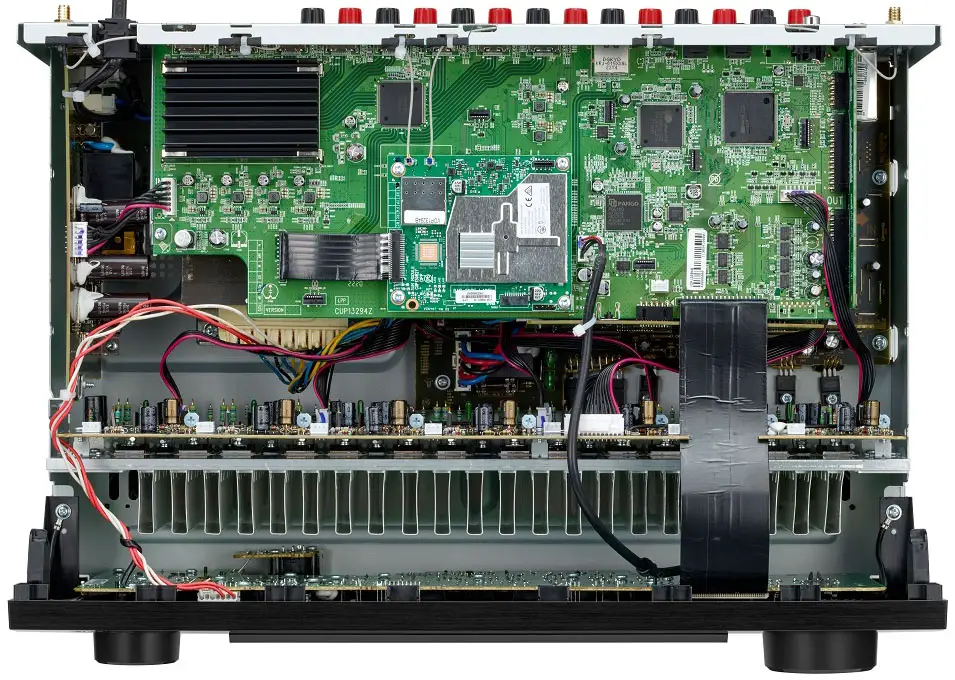
When it comes to up-mixing tech we get Dolby Surround and DTS Neural:X. What these up-mixers do is to up-convert stereo and legacy mixes in order to make use of all the speakers you have in your setup. As for virtual tech the Dolby Atmos Height Virtualization and DTS Virtual:X virtualizers are capable of creating sounds that originate from virtual created speakers around your room where there are no physical speakers present.
These virtual technologies obviously are not as good or accurate as having real physical speakers and are very much room dependent. Also the sound many times can be heard very over-processed, something we were never very fond of. If there is anything missing here that would be Auro-3D along with IMAX Enhanced as both of these are being included in the next in line, the AVR-X3800H.
Τhe AVR-X2800H comes with 7 channels of built-in amplification and each channel can pump 95 watts of power (8 ohm, 20 Hz – 20 kHz, 0.08% 2ch drive). As always you should not be fooled by this number as manufacturers always give ratings with 2 channels driven meaning that when all 7 channels are active this number goes down considerably.
With the supported channels you can go all the way for a 5.2.2 channels audio setup with two dedicated overhead speakers for maximum immersion. As we do in all our tests we created a 5.1.2 setup using a single subwoofer and 2 Atmos ceiling speakers placed at the middle, above our viewing area.
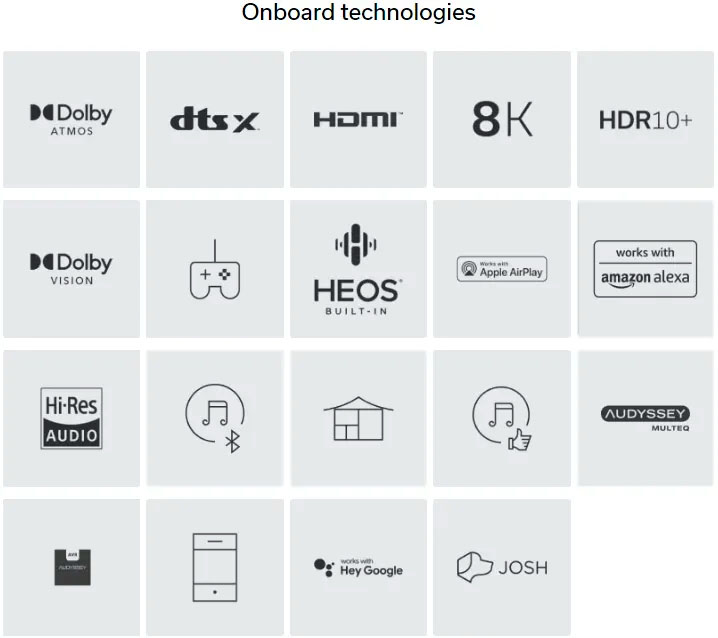
It’s time for our movie tests now and for this one we wanted to try out something different than the usual mayhem filled movies to try out lately. So this time we decided to try It: Chapter two in 4K UHD which uses an incredible Dolby Atmos mix.
It: Chapter two may not be the kind of film filled with explosions and all out destruction but the change of pace and sound design is most welcome. The film relies a lot on ambient and atmospheric effects in order to portray its earie world and give you this constant unsettling feeling which is characteristic of the series.
There is obviously a lot of dialogue and the Denon did a perfect job at keeping everything front and center. All actor’s voices were nicely isolated, there was no overlapping to be heard and everything was clear and distinct even during the more busy and action filled moments.
The two main channels did most of the heavy lifting and we got a nice and expansive front sound wall that had nice depth and sideways extension. The front always is the main attraction and with films that are more dialogue oriented it becomes more obvious than ever.
But while the front part was very pleasing and immersive it was the surround and overhead performance of the receiver that made the whole experience rise to a whole new level.
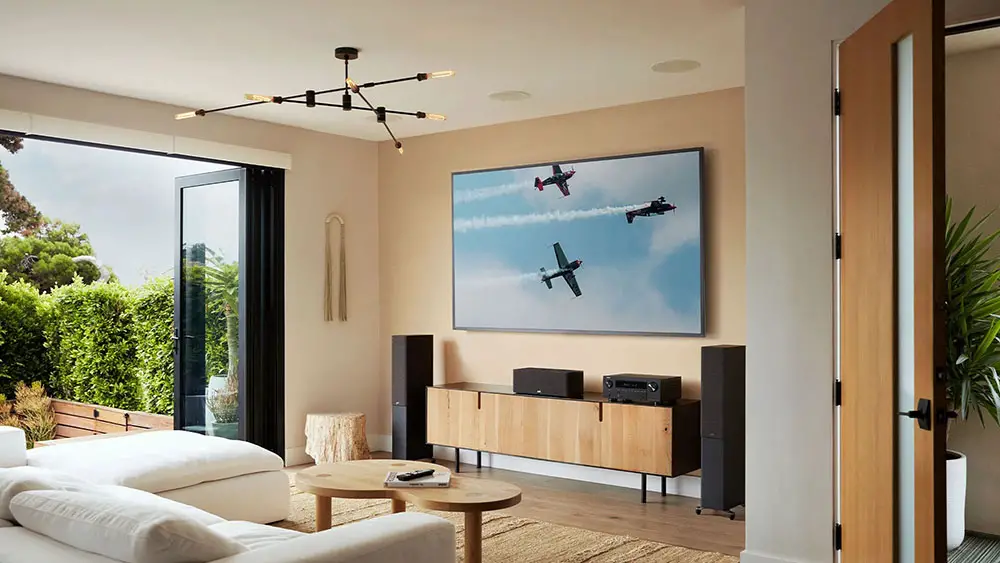
First we start from the surrounds as the Denon pushed the action well over behind us with most of the activity being atmospheric and ambient sounds. The sewers was a good example of that as was the beginning of the film during the carnival. You could hear sounds being emitted not only from the rear speakers themselves but from the entire space behind us showing how capable the X2800H was with rendering sounds in 3D space.
The same could be said about its Atmos performance. Although this was not so much to our faces, as any good Atmos mix should be, but it certainly added a lot of tension and stretched the overhead layer well above ear level. With only two Atmos speakers we did loose a bit of clarity and pinpoint precision but this is not the fault of this unit specifically but of all receivers that can only do two and not four Atmos channels.
Lastly the unit had no problem sending all low end activity to our subwoofer and if you have a good quality one then the kind of rumble and shakes you will get will leave you breathless. Just make sure you set your crossovers right and you will have a very happy subwoofer with the Denon.
For our second test we changed gears and went with The Incredible Hulk in 4K UHD. This one sports an explosive DTS:X mix which is as good as it gets when it comes to action filled content.

Let’s talk about the obvious first. The mix rocks and the Denon made sure to bring all its qualities out and then some. The front was every bit as spectacular as Hulk himself with powerful sonic waves hitting us at every moment. The two main channels showed nice panning effects with fact reaction times and no delay.
Dialogue was once again spot on. Clear as day and at no point you would loose a single word due to the action happening at any moment. Nicely isolated at the center made our day so much easier and our ears more relaxed than ever.
There were moments, like in the bottling factory, that the DTS:X mix showed really how good it can be when paired with a capable receiver that can bring all its qualities forward. There was exceptional surround activity from all sides and all axis. You could hear the belts and bottles from all around as well as above our ear level giving so much more depth and realism to the scene.
The above shows that you don’t really need a scene full of explosions and gunfire in order to appreciate the capabilities of a good DTS:X mix. It can add so much more, even in scenes that you wouldn’t expect it, out of it and the X2800H did know how to handle them.
The final act with the fight of Hulk and the Abomination is obviously the main attraction and the receiver fires on all cylinders here. The level of destruction is breathtaking and if you have a good surround system then the receiver will surely make good use of it.
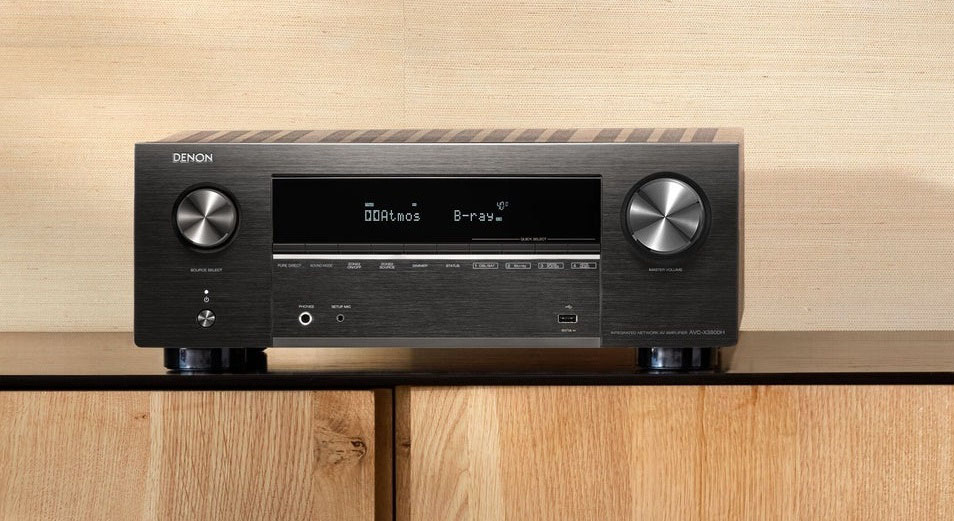
Explosions will shake your walls while gun fire, bullets and missiles will fly past your ears making you almost… duck in order to avoid them. It’s so good that you have to experience it yourself as words can only describe it so much.
Overall if movies is your thing and you are in need of a good 7 channels AV receiver the Denon AVR-X2800H is one that will cover your needs and then some. Nothing more to say about it.
High Resolution Audio is also supported, as previously, so except from the usual low quality MP3, WMA and AAC the receiver can also playback FLAC, ALAC and WAV files up to 192 kHz / 24-bit as well as DSD for both 2.8 and 5.6 MHz. In our case, as we always do in our reviews, we selected a few music tracks in FLAC format that we streamed through the USB port of the receiver for the best possible quality.
And for that we switched to a 2 channels setup which is mostly preferred when listening to music. Keep in mind that the type and quality of the speakers is very important and the AV receiver by itself cannot do miracles without them to work its magic.
In terms of pure audio quality the X2800H behaved very similar to its predecessor and many other Denon receivers of similar category. If there are any differences we surely could not spot them with just our ears.

The receiver can do exceptionally good both with low quality content as well as High Resolution Audio. The X2800H includes a Restorer function that is specially made for low quality music files like mp3 in order to bring them up to their original state.
As always these AV receivers are meant to be used for convenience and will surely not replace a dedicated music system. But even so for most users that want to combine movies and music the X2800H can do wonders.
The sound stage it created felt spacious, had good depth and nice sound imaging. Sources could be heard emitting from specific points in space while stereo panning effects were impressive and very accurate.
The mid-range frequencies were nicely balanced without any obvious irregularities and bound nicely with the high end as all of the performers voices were full of emotion and high on energy without becoming bothering.
At the other side of the frequency spectrum the Denon pushed the lows to our subwoofer and due to the sealed design it had the tempo and rhythm was kept intact even during very low end demanding sessions.
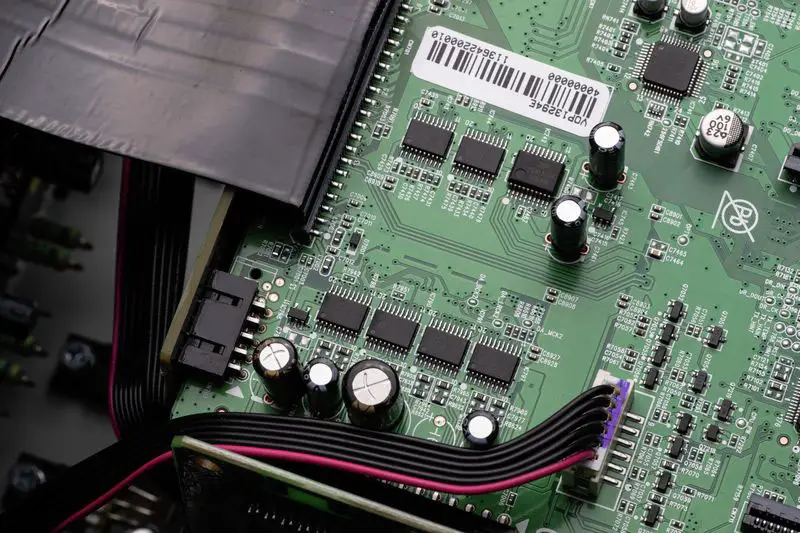
Throwing various genres on the Denon included electronic, classical, some Jazz and a bit of rock with all of them showing exactly the same qualities the receiver had. It will not drop your jaw on the floor but it will not disappoint you either.
The X2800H didn’t have any surprises for us here. Its sound output and quality matched those we had heard before it very closely. If there are any differences then you cannot hear them without any measuring instruments. The receiver may be the most impressive with movies but will do great with music sessions too if it needs to. And this shows the value this AV receiver has making it an excellent choice for mixed use.
Ports and Connectivity
The AVR-X2800H may look completely the same as its predecessor but there are also some distinct differences between the two and these are mainly on the ports configuration and layout.
We already mentioned above about the frontal ports that include the Headphones jack, the setup microphone port and the USB port. The front HDMI port is still missing in action so no changes here.
At the back of the unit the first thing that catches the eye are the 7 speaker terminals placed in a straight line at the bottom which helps a lot with cable management. The terminals are the usual quality we have seen from Denon so all is good here with good quality plastic caps while each terminal has its own amplification.
At the top we find the HDMI inputs and the AVR-X2800H has six of them along with two HDMI outputs.
As for the rest of the connections we get 2 optical and 1 coaxial digital inputs, 1 Ethernet port, 2.2 channels pre-outs with Zone 2 and dual subwoofer ports, 4 analogue audio inputs and one more dedicated for phono, an RS-232C port, 1 IR input and 1 output and the usual FM/AM antenna inputs along with the WiFi/Bluetooth connectors.
The most notable difference the X2800H has in comparison to the X2700H is that Denon decided to take out all component and composite ports. A few days ago in their presentation for the new AV receivers they mentioned that they would slowly take out all analog ports.
And while this may be a cut costing decision, most devices nowadays use HDMI connections anyway and buying such a unit most probably means that you have much newer equipment to connect to it.
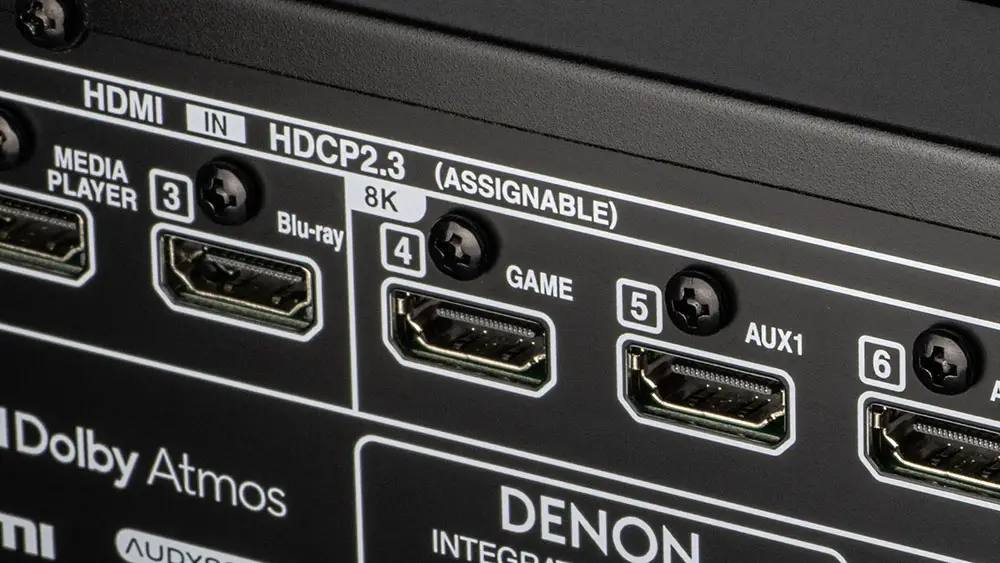
As for its HDMI ports the X2800H comes with three HDMI 2.0 ports capable of 18Gbps and three more HDMI 2.1 ports that support all the old and new exciting technologies including 8K/60Hz and 4K/120Hz video passthrough, 40Gbps bandwidth, 4:4:4 Pure Color sub sampling, HDR10, HDR10+, Dolby Vision, Hybrid Log-Gamma (HLG), Dynamic HDR, 3D, BT.2020 pass-through, Quick Media Switching (QMS), Variable Refresh Rate (VRR), Auto Low Latency Mode (ALLM) and Quick Frame Transport (QFT).
As you probably guessed from the above, is the fact that the AVR-X2800H comes with the new unaffected HDMI 2.1 ports. All the 2020 AV receivers that featured HDMI 2.1 ports came with a bugged Panasonic chip that wouldn’t allow it to pass certain signals, like 4K/120Hz RGB signals from the Xbox series X for example, as it would result in a black screen.
The AVR-X2800H on the other hand seems to be using an updated version of this HDMI 2.1 chip which allows up to 40Gbps of bandwidth in three of its HDMI ports and this includes all the signals with a 4K@120Hz configuration including Xbox Series X.
As part of our review we connected an Xbox Series X to our TV to see if we could really get an unaffected signal. And indeed we did with a 4K@120Hz with VRR signal being passed through the receiver to the TV without any problems during our tests.
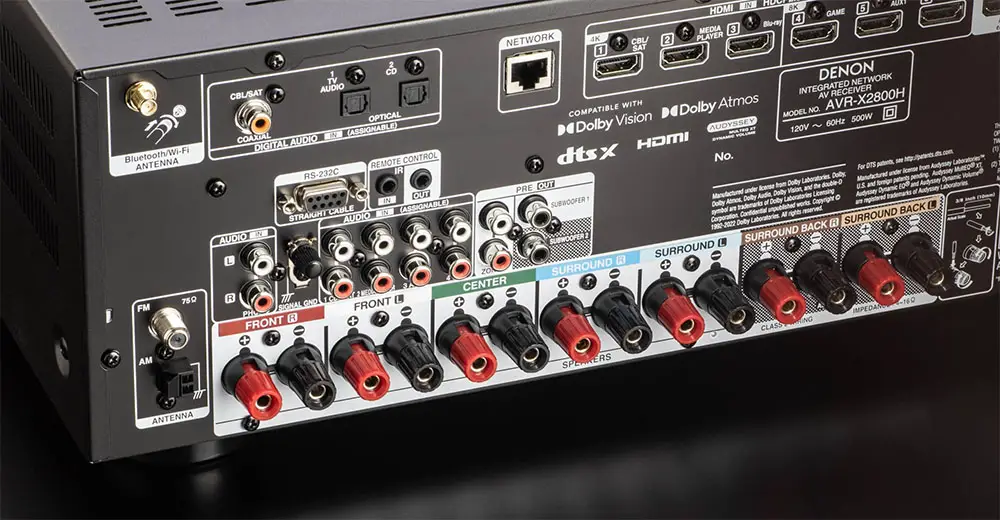
As for the unit’s wireless capabilities we get built-in WiFi which can connect both in 2.4GHz and 5 GHz networks while it seems we get a minor upgrade here as its WIFi is now able to support up to IEEE 802.11a/b/g/n/ac.
The AVR-X2800H supports Bluetooth 4.2 and Bluetooth streaming, as most Denon receivers, which may not be as efficient as the newer v5 but at least during our testing we didn’t notice any lagging or connection problems.
The most notable changes of the X2800H compared to the X2700H is the inclusion of three, trouble-free HDMI 2.1 ports instead one the one and the phasing out of all composite and component ports. If there is one thing we will keep asking from Denon that would be to bring the front HDMI port back again, as we consider it a very practical feature and needs to make a return.
OS, Apps and Features
Now let’s take a look at what extras and features the receiver comes with. Looking at the whole list available we do not find a lot of differences or changes compared to the X2700H which already had a very extensive feature set. But there is one distinct difference we will talk about.

But first things first and we will start with the audio calibration system. Denon is using the Audyssey system and as with all manufacturers they scale it accordingly to meet the price and performance standards of each of their models. For the X2800H we get the Audyssey MultEQ XT version which is a step lower than the XT32 version which is their best and most feature complete suite. In comparison this one features lower resolution filters which can result in less accuracy.
The Audyssey MultEQ XT also comes with Dynamic Volume and Dynamic EQ. This version of Audyssey has the ability to analyze up to 8 different listening positions with the help of the included microphone and creates precise digital filters in order to offer the best audio result for your particular space.
But expect from the core system we also get Dynamic EQ which is a feature that is responsible at keeping the clarity and dynamic levels of audio even when you like to watch at low volume, like for night viewings for example. Dynamic Volume on the other hand is capable of balancing sudden changes and spikes in volume that could appear when there are sudden changes from TV broadcasting to commercials.
Going through the Audyssey calibration can be done either through the built-in wizard or if you want to dive deeper into calibrating your system then you can download the Audyssey MultEQ Editor app that is available for Android or iOS and do a more thorough setup with the help of your mobile device. Only keep in mind that this app has a one time fee which is a shame but it is what it is. As for the built-in system this is more than enough for most casual users as it offers almost anything you need to make very good and precise adjustments to your system.
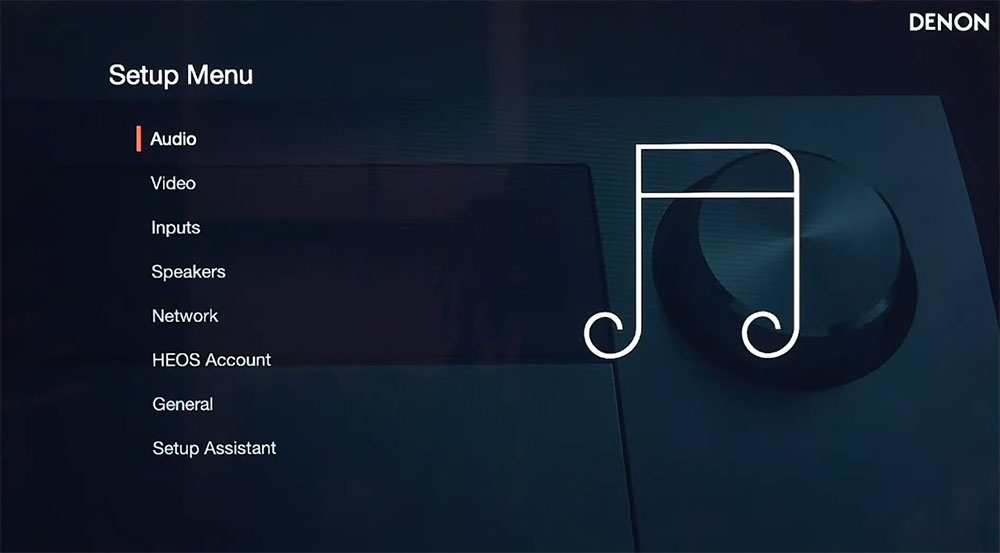
But Denon provides another app for this AV receiver and this one comes completely free. The Denon 2016 AVR Remote app, as it is called, lets you control the unit with your mobile device through a nice visual interface. If you are tired of the included remote this is a nice and most important free alternative. The app is available for both Android and iOS devices so we suggest you give it a try to see if you like it.
Next we will talk about the UI and here is the most notable change compared to the X2700H. For some years now we were complaining about how old style and outdated the UI of the Denon AV receivers looked. It was a though it belonged in the early 2000s with its simple menus and 480p resolution.
It seems that Denon finally listened to our cries and decided to update the looks of it. The menus are not all that different in terms of structure and layout. You still get the same list of features in a similar way to the old UI but they bumped the resolution up to 1080p and made it look graphically more pleasing to the eye. Now it feels like it is something newer and although it may not be as fancy as what smart TVs have it is far better that what we were getting till now.
As for the rest, the receiver comes with the usual streaming as well as multi-zone capabilities that Denon includes in almost all their units. As it supports both HEOS and Airplay 2 you can either stream music online from one of the available online streaming services that include Spotify Connect, Pandora, Amazon Music HD, TuneIn, Deezer, SiriusXM and TIDAL among others or create your own multi-room environment with the use of appropriate wireless speakers.

Both the HEOS and Airplay 2 apps are available for downloading from their appropriate stores for use with your mobile device. But if you prefer a wired connection the AVR-X2800H also supports Zone 2 through its 2.2 channels pre-outs available at the back of the unit.
Now as far as streaming, online is not the only option you have as you can stream audio from a network drive or NAS server if it happens you to have one connected to your local network. Also with the included USB port you can stream music through some connected external storage or flash drive. Lastly if you prefer a more wireless way of streaming your music there is Bluetooth available for connecting with your mobile device. If you use Apple devices then Airplay 2 can also be used to stream music wireless through it.
And since we mentioned Bluetooth another function that is included in the X2800H and seems to become a standard is that the receiver can output audio in two different ways using its Bluetooth transmitter. The X2800H is capable of streaming audio to Bluetooth enabled headphones for a completely silent house experience or it can also output sound from both its speaker terminals and to a Bluetooth headset. This can be particularly practical in case there is a member in the family that is hearing impaired.
But keep in mind that this can be used only for music and not for movies. And this happens because the Bluetooth transmitter of the AV receiver is using only the SBC codec and not some more advanced variant meant for such use, like aptX Low Latency. As a result there is bound to be an audio delay due to the Bluetooth transmission speed making this feature ideal only for music use.
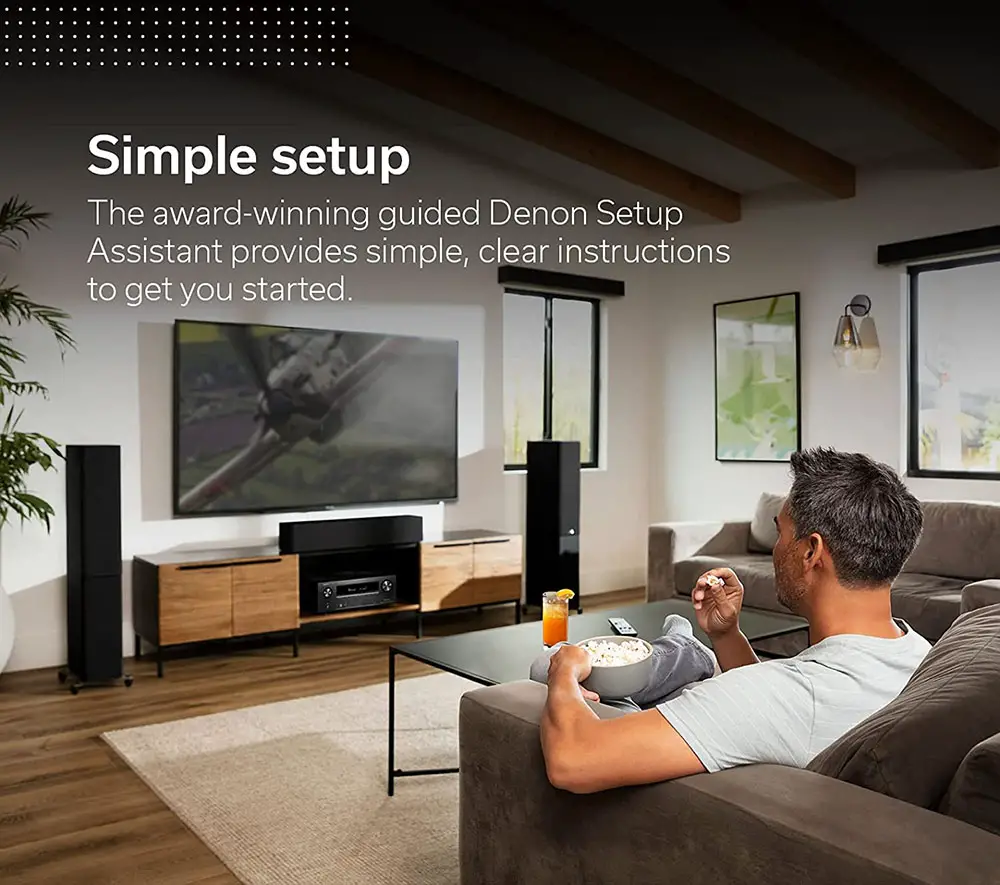
Denon is known for including all known voice control platforms to most of their models and the X2800H isn’t any different in this regard. As such there is support for both most known ones with Amazon Alexa and Google Assistant but there is also support for Apple’s Siri through the Airplay 2 app and the advanced automation system Josh.ai making this receiver complete in every way.
Another handy feature that we do find is HDMI-CEC and this one lets you use the TV remote to control the AV receiver if the TV also supports this. You can understand the practicality of this as this way you can reduce the amount of remotes you will need to have in your home theater. Obviously this feature lets you use only the most basic functions of the receiver but for everyday use it can be a very time saving one.
There are even more extras and features available so we will try to name as many of them as we can. The receiver supports video upscaling to 8K resolution but the obvious limitation here is that the X2800H can do that only through its HDMI ports as all analog ports are taken out. We also get an ECO mode that can regulate the receiver’s power usage for a more environmental friendly power consumption as well as being “Roon Tested” certified.
For this last one there seems to be a bit of confusion as there are two types of certifications. Roon Ready and Roon Tested. The AVR-X2800H, as with all Denon AV receivers, is Roon Tested which means while Roon will work on this unit you will not get the highest quality possible. So for example if you use Airplay, audio quality is limited to 16 Bit/44.1kHz. Keep that in mind in case Roon is specifically important to you but also want your files to be streamed in their original quality.

Final Thoughts
A lot of people are wondering if it is worth it to go for the more expensive X2800H instead of the much cheaper X2700H, while still in circulation, so we will make things as clear as possible. If high frame rate gaming is your priority then yes, the three 40Gbps HDMI 2.1 ports of the X2800H will make a difference. In any other case both of them are so similar that is not worth the higher price.
The Denon AVR-X2800H is an amazing AV receiver really. It took everything that was good in the X2700H and added three full bandwidth HDMI 2.1 ports, a new refreshed UI and made a minor upgrade to its WiFi module. If you take into consideration the amazing surround performance it has, the huge list of features and its extensive online functionality this unit is a no brainer really.
Are there any downsides to the X2800H? Well, Denon took out all composite and component ports which is something that some consumers may not be very pleased to hear. Also we still miss the front HDMI port while the Audyssey MultEQ Editor app is not free which is unacceptable if you ask us. A refreshed design of both the main unit and the remote would be nice as it has become old over the many years it has been used while its price is surely higher than what the X2700H retailed for when released.
The Denon AVR-X2800H is your typical Denon product. Its looks may not excite you but it is its performance that makes all the difference. And here Denon delivers. If you are looking for a 7.2 channels AV receiver the X2800H should definitely be in your short list for consideration.
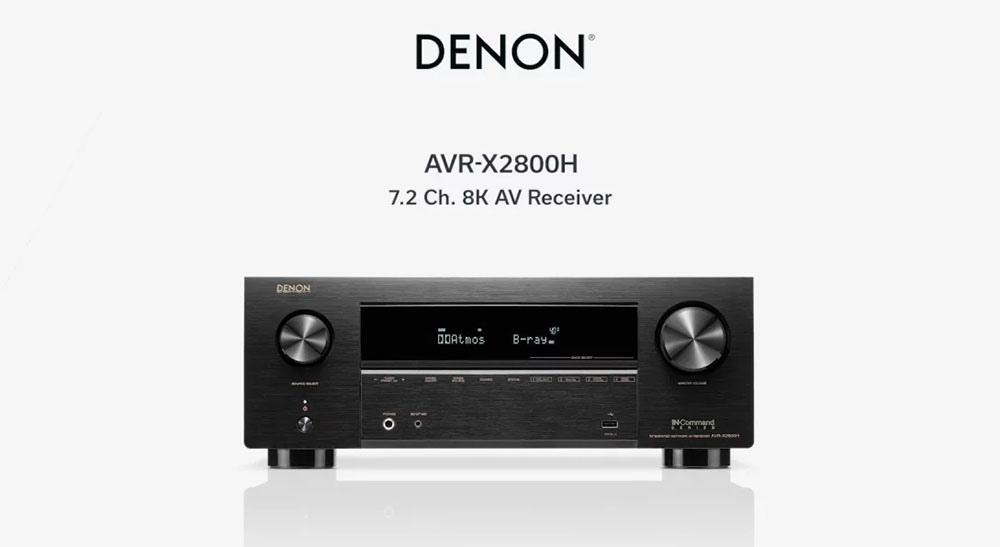
For more reviews you can check our dedicated 7 channels 8K AV Receiver reviews list or even look at our Product Reviews Table where you can find the brand and specific product you are looking for.
Cheapest Places to Buy :
*We are a reader-supported website. When you buy through links on our site, we may earn a small affiliate commission at no extra cost to you. Home Media Entertainment does not accept money for reviews.*
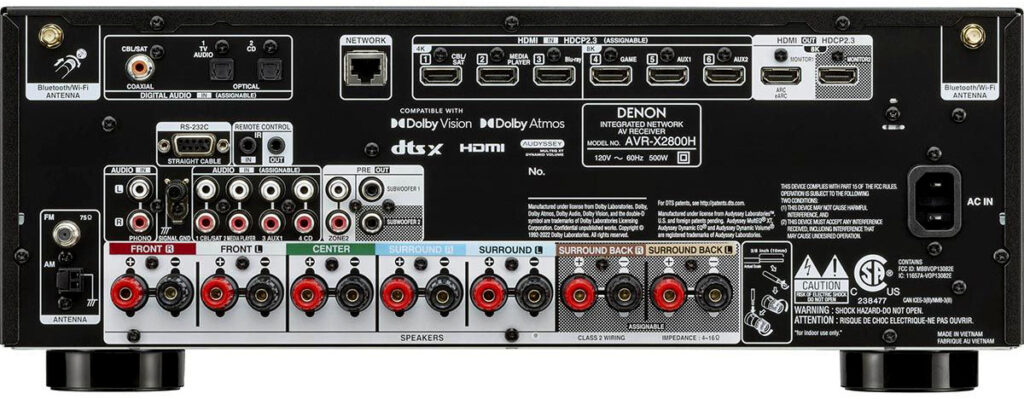
Hello Stratos,
I have been waiting for a long time for Denon to bring out their new bug free HDMI 2.1 AV receivers. Finally they are here! Personally I am waiting for your X3800H review as this is the one that interest me the most. Do you have a timeframe when you will test it?
Regards,
Rohit
Hello Rohit. Review is in the making so hopefully we will publish it soon enough. Take care!
I recently saw the presentation of Denon on Youtube and to be honest the X3800H seems like the more interesting from the two. But finally we have more AV receivers with fully working HDMI 2.1 ports. It’s been two long years on the waiting and in the end I did good to wait for this to be fixed. Great review by the way.
Hey Liam. Indeed the fixed HDMI 2.1 ports was something that a lot of people were waiting for and this is the reason why it took 2 years to see new units in the X series.
Hi, Stratos. I have a question – Denon x2800h or x3700h ? Primarily regarding audio quality…It will be used as 5.1.2 system. A little gaming, mostly movies and music. Thank you.
Hey there. My obvious question would be, at what price you can get them? Because the X2800H is better for gaming and has exactly the channels you need but on the other hand the X3700H has more power but you may have problems with its HDMI 2.1 port and also you will have unused channels which rises the question if it is worth it…
Tell me at what price you can find them and what use you will make mostly and I will give you a better answer.
Well, here in Southern EU, I can get X2800H cheaper for maybe 350 euros. I have seen that X3700H has only one 8K input (vs 3 ) but I wonder how much it will make difference for my use since I only will play Playstation occasionally. Sure, it’s always great option to add 2 more speakers in 9.2 system, but I don’t know if I need it right now. I will mostly use it for movies and music, gaming is not that important…I don’t have option to hear them before buying, so difference in audio quality is the most important thing…is it that much noticeable. Thank you very much for your help. I trust your opinion as an true expert.
Even the bugged HDMI 2.1 port of the X3700H works just fine with either PS4 or PS5. Only Xbox had problems with these ports. Audio quality wise you are not going to understand much of a difference and if you do not plan on going for a 9 channels system then surely your best bet is the X2800H. No need to spend more for something you don’t need.
Thank you very much for your help!
You are welcome. Let me know if you need anything else.
Hi Stratos,
I recently purchased an LG G2 which has eARC capabilities, I am already owning a Onkyo AVR (HT-R 997) which has an ARC capability. But when I hooked it to the AVR I was not getting any sound. When I spoke with the local technician he told its an issue with the AVR and only optical cable can be used (But it misses out streaming high end audio formats). Tried browsing many forums but was not able to sort this issue.
I am looking to change the AVR maybe in some time. I am from India and AVR’s are usually costlier due to the import duty and stuffs. The X2700 is currently available for $786 and the X2800 for $1295, while the X2800 seems to be more costlier. What do you think about it. I am also looking to sell off the old AVR that I currently use.
Hello Arun. If the AVR has only ARC then using either the HDMI or optical would be one and the same as ARC cannot pass anything more than Dolby digital, Dolby Digital Plus or DTS. Exactly the same as the Optical port can. That’s why the technician suggested you so. Now as for the reason why ARC is not working there are many factors. Has you set the LG TV to output through its ARC function? To do that you need to set the HDMI Input Format to ‘Bitstream’ and Digital Sound Output to ‘Auto’. If you don’t do this you are not going to get sound out of the ARC connection. Also check if your HDMI cables are good and that you have enabled the ARC function in the AV receiver also.
As for the X2700 vs the X2800 it really depends on its use. If you are into gaming the X2800 has three HDMI 2.1 ports. If this does not interests you then the X2700 is completely fine and will cover you entirely.
Hi Stratos,
I am in Canada and I am looking at replacing my aging Pioneer VSX-1019AH-K 7 Channel A/V Receiver, with either the Denon X2700 or X2800. I have a new 65″ Hisense U8H ULED 4K TV with eARC/ARC.
We are not gamers, we watch streaming content (Movies, series shows and a LOT of sports) and listen to streaming music (Spotify) and we play a LOT of vinyl on a turntable connected to the AV receiver. We enjoy an immersive movie experience ( I have yet to add ATMOS height speakers).
I can get the X2700 for approx. $500 cheaper than the X2800 right now, which is a significant savings.
Is the extra for the X2800 worth it for our purposes?
Are the improvements in the audio and voice processing worth the extra $ compared to the X2700?
I have read a review from WhattheHiFi that suggests there are some improvements in the sound quality of the X2800 vs the X2700.
The X2800 also supports HDR10+, is that a big deal?
Thanks!
Wayne
Hello Wayne. If you are not going to use it for gaming then it is not worth it to go for the X2800H. The X2700H also supports HDR10+ but Dolby Vision has far more support so this shouldn’t worry you too much. So with these in mind I would suggest you go for the X2700H and save some money.
Hi Stratos,
Thanks for the reply, the X2700H is not available for the price anymore. 🙁
I am wondering about the AVR-S970H vs the X2800H.
I think the main differences are:
90W vs 95W power
Audyssey MultEQ vs Audyssey MultEQ XT
X2800H has 2 zone preouts
460W power supply vs 500W power supply
The S970H is about $350 cheaper than the X2800H, is the X2800H worth the extra $$?
Thanks
Wayne
Hey Wayne. The differences between the S970H and the X2800H are very small and the features missing are not so much important. If you can get the S970H for $350 less then I would suggest to go for that one.
Hello Stratos, I am getting the Denon X2800 and Marantz SR5015 at almost the same price. I would be using the AV more for music & movies in a 5.1.2 configuration. The Marantz is rated higher for performance but I think the Denon is a newer model so may have better components. So which would be your choice? Regards.
The only major difference is that the X2800H has three, bug-free HDMI 2.1 ports while the SR5015 has only one. Also if it is an older stock model you are running the risk of getting a piece with the bugged HDMI chip which plagued all the 2020 AV receivers. The 5 watts advantage of the SR5015 is negligible. So if you can find them at exactly the same price, the X2800H is the one to go for. No questions asked.
Hi,
I’m in Portugal and i have the opportunity to buy X2800H at 600€ or Onkyo NR6100 at 670€.
I’ll not play games, i will just use apple TV 4K for streaming (video and audio), and turntable.
I have one OLED TV LG 55B7 4K and one projector optoma hd28E
Wich would be your choice?
Thanks
Hey there. Well, since you are not interested in gaming it comes down to what you prefer mostly in terms of features. Yes, the Onlyo has 5 watts more but this is minor overall. If you prefer Audyssey and HEOS you go for Denon. If you prefer AccueEQ, Chromecast, DTS Play-Fi and THX you go for Onkyo. Personally I would go for the Onkyo but if you want to save some money and you don’t care about these extras then the Denon is the definite choice.